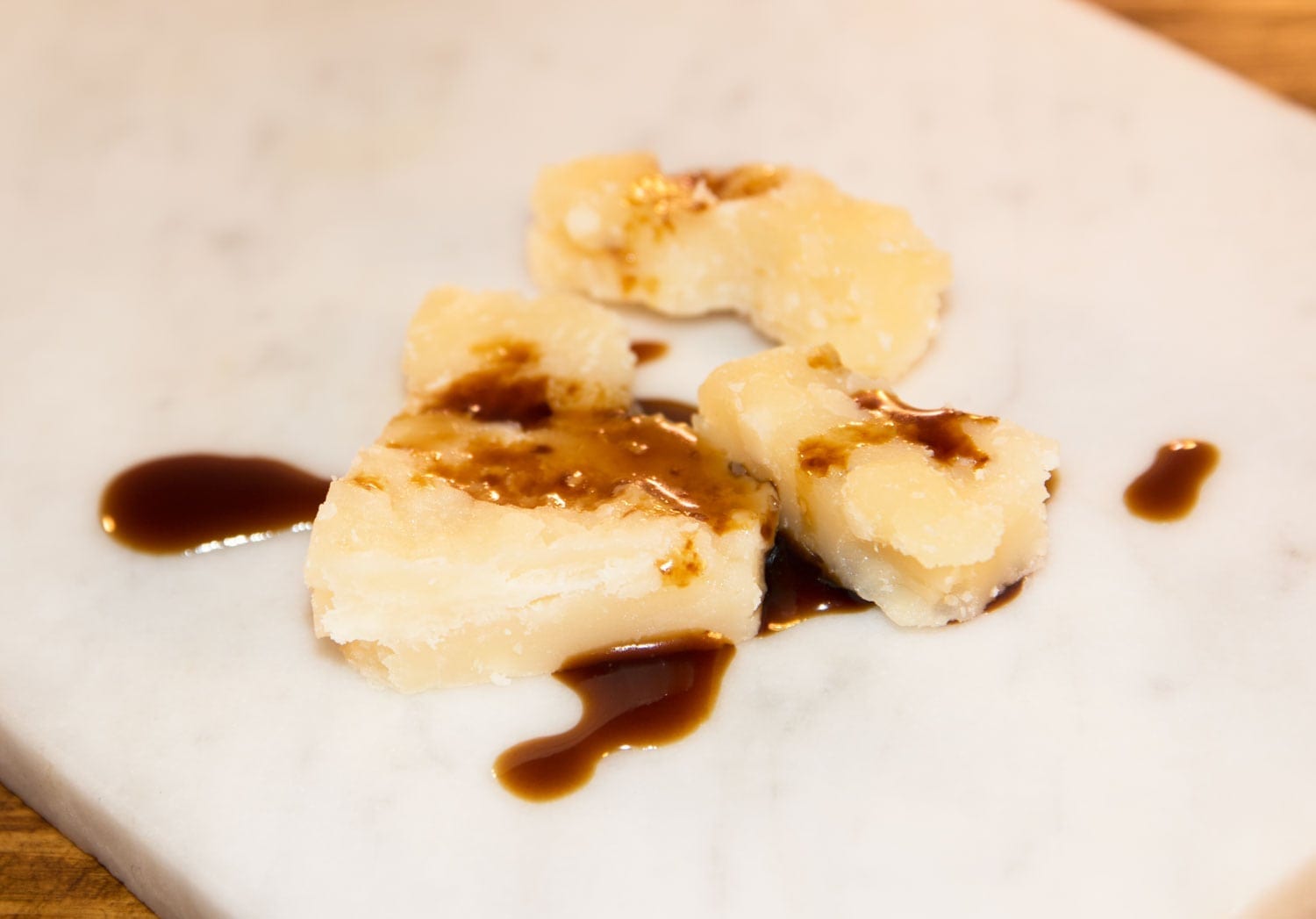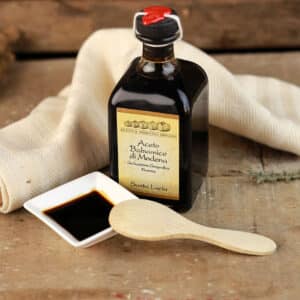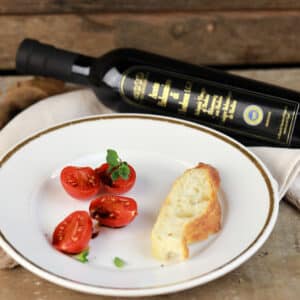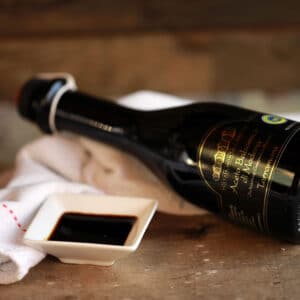[vc_row][vc_column][vc_column_text]If there was a classification of condiments excellence, the Balsamic Vinegar of Modena IGP would surely rise, proud of itself, on the highest step of the podium. Always appreciated and sought after, the black gold of Modena inextricably links its fame to the events of the powerful Este family that ruled for centuries over the city’s Duchy.
Synonymous with culture and tradition, know-how and innovation, the Modena Balsamic Vinegar has its origins in a distant era. Since the time of the Romans, there are testimonies that mention the cooking of the must, if you look even further back beyond the time horizon and geographical, it turns out that already the ancient Egyptians knew and appreciated this practice.
But we proceed in order, because the events of the Balsamic Vinegar are very old and deserve to be told calmly: the road traveled by this mysterious seasoning starts from the dawn of time and arrives straight on our tables, dotted with “delicious” anecdotes and ” precious “testimonies.
In fact, if we had to choose two adjectives that enclose the essence of the black gold of Modena, these would be just delicious and precious.
Balsamic Vinegar of Modena, the Roman origins
As we mentioned, the first written testimonies reached up to us and related to the methodologies and benefits of cooked must are found starting from the texts of the great Roman writers.
Giulio Cesare, in his De Bello Gallico, speaks of a disinfectant “medicine” perfect for digestive tract infections. Virgilio, the great poet, tells in the Georgics of a condiment highly appreciated at the table of the Roman patricians, very widespread in the Modena area and deriving from a particular procedure of cooking the must. This dressing was prepared in three different variations depending on the degree of concentration that characterized the reduction (ten, thirty and seventy percent) and these gave rise to as many products the defrutum, the sapa and the caraenum.
Giunio Moderato Columella, renowned writer of agriculture lived between 4 and 70 d. C., describes this cooked must as an excellent additive for wine and vinegar, and as a sweetener for dishes to replace honey.
Of course we must point out that the cooked must of the Romans was very different, in taste and appearance, from modern balsamic vinegar – their recipes foresaw in fact the addition of honey, spices and aromas such as mint, cumin, juniper and rue – however it can rightly be recognized as its legitimate antecedent.
Balsamic Vinegar of Modena and the Estensi – Medieval and Renaissance period
In the High Middle Ages, we are precisely in the year 1046, the most significant testimony on the Balsamic Vinegar is in the Life Mathildis (work that traces the life of Matilde di Canossa) of Donizone in which the abbot tells of when her father , Bonifacio, gave a precious silver barrel containing a mysterious vinegar to Henry III of Franconia for his coronation. The emperor appreciated the preciousness of the gift so much, that he recognized the primate’s father above all the other lords of the Italian peninsula.
In the Renaissance period, the fame of the balsamic is intertwined with the events of the Este family and other families (noble and less noble) of Modena. The main indications written on “balsamic” or on “special vinegars” as they were called then, are in fact found in the registers of the estensi cellars.
The Estensi were true fans of this precious condiment. In 1556, even before the Este court moved from Ferrara to Modena, their registers reported as many as four recipes. But it is only in 1598 with the establishment in the new capital of the Duchy in Modena that the written testimonies tell us of products very similar to the “balsamic Modena” as we understand them today.
Balsamic Vinegar of Modena between the eighteenth and nineteenth centuries
However, to have the first and true official association between the name “vinegar” and the noblest of its adjectives, “balsamic”, we must wait 1747, it is in fact in this year that for the first time the records of the Estense cellars report the wording of balsamic vinegar.
According to this name, since 1830 the vinegars in the estensi cellars began to be divided into balsamic, semi-balsamic, fine and common. And it is always during the 1800s that the stories related to balsamic vinegar spread out from the court of the Este family and began to involve noble families and not all of the territory. For centuries now, in every house of Modena there was a small vinegar where the balsamic was jealously prepared and kept, whose cooking recipe was secretly handed down from family to family, from generation to generation. Each family had in fact a very special recipe that differed from that of other families for a different combination of raw must, cooked must, wine vinegar and an eventual addition of spices and essences. This situation gave rise to a proliferation of many different balsamic vinegars. Nowadays, the productions present on the market are based on two historical recipes, that of the Agazzotti Family and that of the Giusti Family.
Balsamic Vinegar of Modena PGI today
To date, the first official document of the Italian State that recognizes the Balsamic Vinegar of Modena as a sweet and sour condiment, is the ministerial decree number 3 of December 1965. In 2009, it is then recognized a disciplinary production IGP (Protected Geographical Indication) that defines the paradigms of realization. In 2013 the Consortium for the Protection of Balsamic Vinegar of Modena was established, which is the “custodian of the specification and is a privileged interlocutor in all matters concerning the product at a regulatory level”.
Our company has selected three IGP Balsamic Vinegars produced in the Acetaia of Montale Rangone, produced exclusively with 100% natural raw material – grape must – carefully selected and processed without adding any colorings, condensers or thickeners: Balsamic Vinegar of Modena IGP “Montale” – 500 ml, Balsamic vinegar of Modena IGP “S. Lucia “- 250 ml, Balsamic Vinegar of Modena IGP, “Terramara” – 250 ml.[/vc_column_text][vc_custom_heading text=”I nostri aceti balsamici” link=”url:https%3A%2F%2Fsalumigombitelli.it%2Fcategoria-prodotto%2Fcondimenti-e-spezie%2F||target:%20_blank|”]
-
Condiments and Spices
Balsamic vinegar of Modena IGP “S. Lucia “- 250 ml
Rated 0 out of 5€21,90 Select options -
Condiments and Spices
Balsamic Vinegar of Modena IGP “Montale” – 500 ml
Rated 0 out of 5€17,90 Select options -
Condiments and Spices
Balsamic Vinegar of Modena IGP, “Terramara” – 250 ml
Rated 0 out of 5€18,90 Select options





